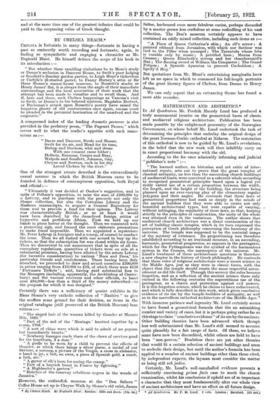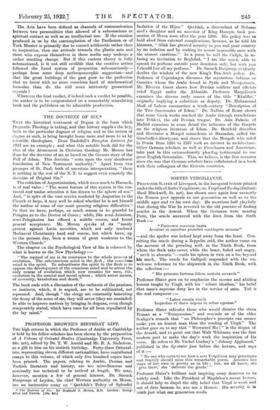MATHEMATICS AND AESTHETICS.*
IN Ad Quadralum Mr. Fredrik Macody Lund has produced t■ truly monumental treatise on the geometrical bases of classic and mediaeval religious architecture. Publication has been made possible by the enlightened generosity of the Norwegian Government, on whose behalf Mr. Lund undertook the task of determining the principles that underlay the original design of the great Norman-Gothic cathedral at Nidaros. The restoration of this cathedral is now to be guided by Mr. Lund's revelations, in the belief that the new work will thus infallibly carry on in exact proportional harmony with the old.
According to the for once admirably informing and judicial "publisher's note" :—
"The learned author, an historian and art critic of inter- national repute, sets out to prove that the great temples of classical antiquity, no less than the succeeding church buildings of mediaeval times, were conceived as a coherent whole according to recognised geometrical. principles based upon a logical yet richly varied use of a certain proportion between the width, the length, and the height of the building, the structure being planned upon an ever-varying play of the elementary regular polygons and their angles. He contends that these laws of geometrical proportions had sunk so deeply in the minds of the ancient builders that they were able to create not only beautiful architectural types, but were capable of varying, without infringing, the regularity of these laws, so that, keeping strictly to the principles of construction, the unity of the whole was attained even in the variations. The author shows that mediaeval churcli architecture was a direct continuation of the art of building classic temples, which in its turn expressed the perception of Greek philosophy concerning the harmony of the universe. The temple was supposed to be the material image of the mystery of existence. Its proportioning was therefore established according to an irrational measure, in an ascending, harmonic, geometrical progression, as appears in the pentagram, which for the Pythagoreans was the symbol of the harmonious system in the Cosmos, the masterpiece of the universe. Mr. Lund's treatment of these architectonic questions is therefore a new chapter in the history of Greek philosophy. He contends that these rules of religious architecture were a secret science in the Middle Ages, just as they were in classic times, with the object that the temple should create the same respectful aston- ishment as did life itself. Through this secrecy the rules became forgotten, and as a reflection of the ancient science there only existed in the following centuries the superstitious use of the pentagram, as a charm and protection against evil powers. It is this forgotten science, which he claims to have rediscovered, and which is fully described in this work, which gives conclusive evidence of its use by the temple-builders of antiquity, as well as in the marvellous cathedral architecture of the Middle Ages;' With immense patience and ingenuity Mr. Lund certainly seems to have found a geometrical formula that fits an astonishing number and variety of cases, but it is perhaps going rather far at this stage to claim conclusive evidence" of its use by the ancients. Other building theories have been advanced which though less well substantiated than Mr. Lund's still seemed to account quite plausibly for a fair range of facts. Of these, we believe some have now been discredited, whilst others are held to have been "non-proven." Doubtless there are yet other theories that would fit a certain selection of ancient buildings and seem to underlie their design, but until the author's formula has been applied to a number of ancient buildings other than those cited, by independent experts, the layman must consider the matter as being still sub judice.
Certainly, Mr. Lund's well-marshalled evidence presents a sufficiently convincing prima facie case to merit the closest examination, whilst his conclusions if upheld are of so important a character that they must fundamentally alter our whole view of ancient architecture and have an effect on all future design.
• 44 Quadratics.- By F. M. Lund. 2 vols. London: Batsford. 155 net.]
The Arts have been defined as channels of communication between two personalities that allowed of a subconscious or spiritual contact as well as an intellectual one. If the emotion produced in us by the contemplation of the Parthenon or of York Minster is primarily due to correct arithmetic rather than to inspiration, then our attitude towards the plastic arts and those who express themselves in these media may undergo a rather startling change. But if this curious theory is fully substantiated, is it not still credible that the creative artists followed the Lund system of proportion subconsciously— perhaps from some deep anthropomorphic suggestion—and that the great buildings of the past grew to the perfection that we know with no more conscious heed of mathematical formulae than do the still more intricately geometrical crystals ?
Whatever the final verdict, if indeed such a verdict be possible, the author is to be congratulated on a remarkably stimulating book and the publishers on its admirable production.



































 Previous page
Previous page